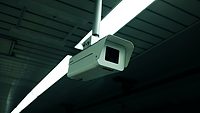Surveillance and ports seem to go hand in hand – travelers hardly notice the myriad security cameras in airport terminals, and ferry passengers are similarly unsurprised when their transportation and loading areas are markedly under surveillance. However, not all surveillance cameras, systems or even analytics are fit for port security, as Steve Vandor soon discovered.
Vandor is the deputy director of IT for the Washington Department of Transportation, Ferries Division – including the largest ferry system in the United States, the Washington State Ferries. In 2010, the existing surveillance system was becoming obsolete, both from aging equipment and a looming lack of support from the manufacturer. In 2011, the state-run entity began implementing a new system with G4S Technology.
“Our previous vendor didn’t know enough about ports and water vessels,” says Vandor. “The old equipment generated a lot of heat, and we had to keep very small spaces on our vessels cool for that equipment.” Additionally, he adds, “Ruggedization is not standard for surveillance equipment, especially with the salt in the fog here on the Puget Sound.” Addressing these issues, which could impact a fast turnover of expensive equipment, was one of the prime focuses of the installation. Another major advantage of the new security system lies in the analytics.
The number of potential security events in the course of an hour for the 2,000-square-mile ferry system and 20 terminals is in the thousands, Vandor says. “Our old system didn’t do well to filter out the nonsense. We wanted a system to execute a lot of rules, associating events into groups for evaluation by the security department.
“A lot of events, by themselves, are innocuous. For example, a boy and his father are poking about the docks, where people normally aren’t going, because they’re mad about boats. That shouldn’t alert security. But a person, at night, in a hood or balaclava, that should trigger an alert. Our challenge lies in how we can deliver these parameters,” he adds. Constructing these rules “is the highest kind of service that IT can provide security.”
At Port Fourchon, on the Gulf Coast in Louisiana, carefully planned analytics are a large part of maintaining vigilance at the busy port, through which 20 percent of the nation’s oil supply is supported.
“Our surveillance system helps us by using analytics to alert us of anomalies and then allowing us to verify those reports from a central location,” says April Danos, Director of IT for Port Fourchon and the Greater Lafourche Port Commission. Port police have remote access to the 1,700-acre port’s surveillance cameras in their vehicles for situational awareness while on patrol using a Milestone IP video management platform. Simultaneously, monitoring personnel in the central control center use a Touch Assisted Command and Control (TACCS™) platform to view alerts, tied to locations and pictures, and then triage the situation appropriately.
“We wanted to invest in a system that could help us protect our assets and our tenants’ assets every day as well as during a disaster. This system helps us improve real-time collaboration with our tenants, who give us monitoring access to their on-location cameras,” says Danos. “Our overall goal is for police to be aware of emergencies before a 911 call.”
The latest system upgrade to the port’s surveillance came in 2010, and due to a decision to streamline the surveillance process instead of replacing it altogether, the cameras could stay in place as the infrastructure was swapped out for IP-compatible technology run through a unified network-based system.
“It’s a cost-effective and user-friendly system that amplifies what we already have,” says Danos. “The port is constantly growing and changing, and we needed a system that could keep up with this sort of dynamic environment. Now, in both everyday and emergency situations, we can give accurate, real-time directions to first responders and ensure they get to the scene of the incident as quickly and safely as possible. Our system makes a lot of business sense, because it helps us support day-to-day operations as well as emergency response in one common operational picture.”
The security team at the Long Island MacArthur Airport (LIMA) also sought to add to their existing surveillance investment, while adding IP-based high-definition (HD) camera coverage to areas that were not yet under surveillance, including a new Southwest Airlines terminal, the new FAA tower and perimeter gates around the entire airport. The airport worked with IPVideo Corp. to convert existing analog cameras to an IP-based video management platform, saving more than $200,000 in the process.
According to Greg DeCanio, the Chief of Law Enforcement at LIMA, the new video management system provides airport security personnel with “the ability to access video at our computers, making us more efficient and letting us monitor activity for security and law enforcement purposes at the touch of a button.”
“The quality of the HD video with the panning and zooming features of the cameras have been so helpful in our security efforts,” he says. “There have been multiple cases when we have needed to go to the video archives and IPVideo’s solution has assisted us in successfully completing investigations. We have been able to go back to these archives and quickly find what was needed. The system has made our lives easier and, most importantly, more secure for all who travel through and operate in our airport.”
Officers can use the new HD cameras to capture facial details and aid officers in identifying persons of interest and resolving incidents. They can also use the system to improve overall customer service by quickly reviewing video to help travelers find lost property and locate cars in the parking lot.
Ray Davalos, the Building Systems Manager at Miami International Airport, is also using technology to support, not replace, his staff. PSIM (Physical Security Information Management) and other software help the airport’s security team mitigate any internal threats.
“Our top priorities are instantaneous sharing of information between security stakeholders through the use of a consolidated system,” he says. “We require all parties to share relevant information at a moment’s notice. … We can leverage on-site staff and tenants as vigilant eyes and ears to detect anything out of the norm. They are trained in behavior pattern recognition and can report any threat via their smartphone to a security Web portal. The system analyzes this big data and reports to the proper stakeholder for investigation.”
Working with technologies from NICE Systems and Frontier Security, Davalos is working to secure the airport facilities in layers with technologies that will assist people, not replace them, he says.
“One of the biggest trends I’ve seen lately is complacency due to the time that has elapsed since 9/11,” says Davalos. “Obviously, complacency is a threat to any organization. In addition, we have the recent copycat trend with active shooters or even stabbings – really, any internal threat to innocent people. This trend can easily migrate from the schools, movies and universities, and into our public front doors.
“Technology that increases situational awareness and speeds response is one key way to address these trends. Security officials must have immediate access to the video, access control and other data they need to respond to a threat quickly and effectively. And if the technology can also leverage the power of other employees or, as in our case, tenants, situational awareness will be even greater.”




